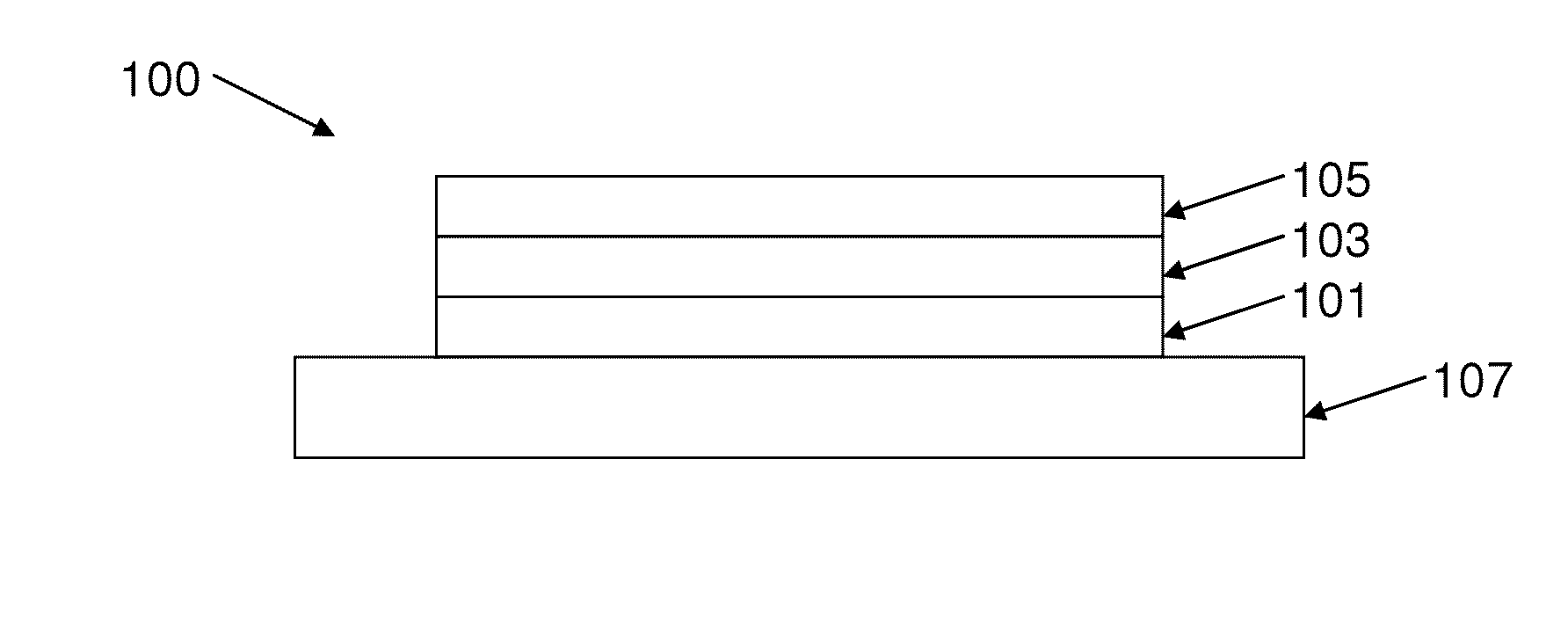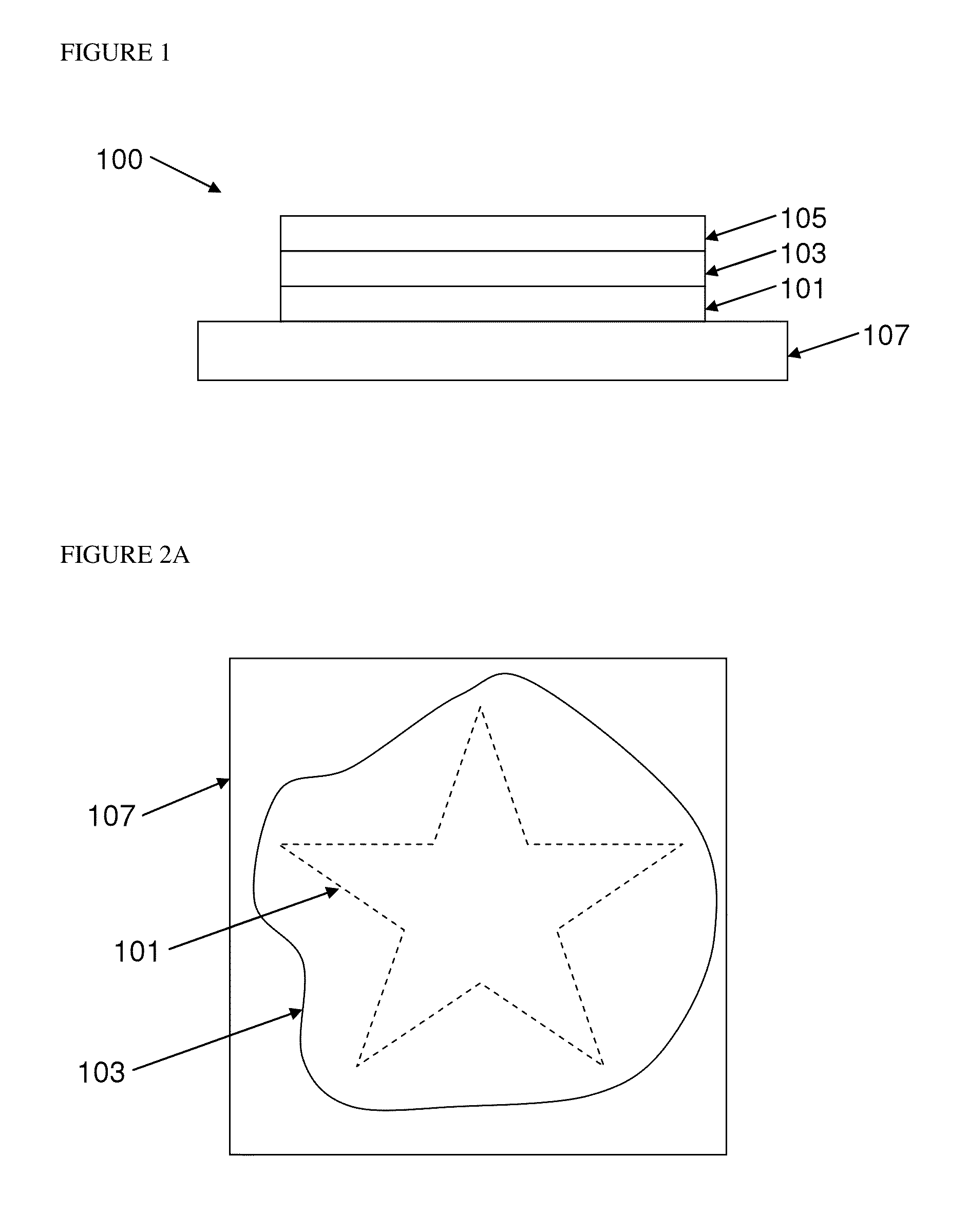Composition and device
a technology of composition and device, applied in the direction of non-metal conductors, conductors, thermoelectric devices, etc., can solve the problems of poor uniformity of device emission and device yield issues
- Summary
- Abstract
- Description
- Claims
- Application Information
AI Technical Summary
Benefits of technology
Problems solved by technology
Method used
Image
Examples
example 1
[0161]Ink formulations used for comparing the impact of a high molecular weight additive on printed film uniformity are presented in Table 1.
[0162]Comparative Ink Formulation 1 and Example Ink Formulation 1 containing the components in the amounts given in Table 1 were prepared by dissolving a light-emitting polymer, 300K Mv polymer electrolyte and salts in a solvent mixture of 4-methylanisole and 1,3 dimethoxybenzene. In the Example Ink Formulations a portion of the 300K PEO electrolyte has been replaced by 5M or 8M Mv PEO.
TABLE 1Comparative and Example Ink FormulationsWeight percentage (Wt %)MaterialComparative Formulation Example Formulation Formulation11LEP1.61.6PEO 300K0.270.216PEO 5M or 8M—0.054DBE-8210.140.14THA+PF6−0.080.08THP+BF4−0.0530.0534-methylanisole48.948.91,3 dimethoxybenzene48.948.9THA+PF6− is tetrahexylammonium hexafluorophosphate.THP+BF4− is trihexyltetradecylphophonium tetrafluoroborate.DBE-821 is dimethylsiloxane-ethylene oxide block copolymer available from Gel...
example 2
[0167]Example Formulation 2 was prepared as described in Example 1 except that a combination of low molecular weight PEO (Mv=100,000) and high molecular weight PEO (Mv=8,000,000) was used. The low Mv PEO:high Mv PEO weight ratio was 90:10. The viscosity of the formulation was 6.6 cP.
[0168]For the purpose of comparison, Comparative Formulation 2 was prepared wherein the low and high Mv PEO electrolytes were replaced with a single polyelectrolyte having a Mv value of 300,000. The comparative formulation had a viscosity of 6.7 cP.
[0169]Films were formed from the two compositions. The film was dried at 120° C.
[0170]The surface roughness of the films (Ra) was measured using a Veeco Nano scope—V AFM system used in tapping mode.
[0171]Ra of the film formed using Example Formulation 2 was 24 nm.
[0172]Ra of the film formed using Comparative Formulation 2 was 33 nm.
[0173]Without wishing to be bound by any theory, it is believed that higher molecular weight polymers may result in greater surfac...
PUM
| Property | Measurement | Unit |
|---|---|---|
| width | aaaaa | aaaaa |
| width | aaaaa | aaaaa |
| viscosity average molecular weight | aaaaa | aaaaa |
Abstract
Description
Claims
Application Information
 Login to View More
Login to View More - R&D
- Intellectual Property
- Life Sciences
- Materials
- Tech Scout
- Unparalleled Data Quality
- Higher Quality Content
- 60% Fewer Hallucinations
Browse by: Latest US Patents, China's latest patents, Technical Efficacy Thesaurus, Application Domain, Technology Topic, Popular Technical Reports.
© 2025 PatSnap. All rights reserved.Legal|Privacy policy|Modern Slavery Act Transparency Statement|Sitemap|About US| Contact US: help@patsnap.com



